Visit Glasgow in 2 days
15 must-see POIs, optimized routes and anecdotes.
Loading map...
You will visit the most beautiful points of interest in Glasgow


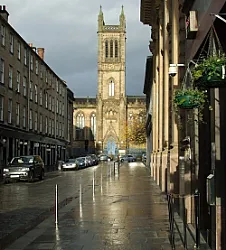
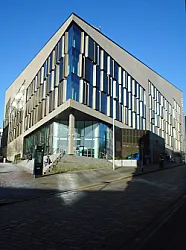
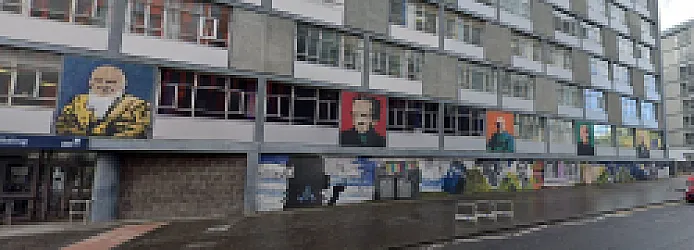


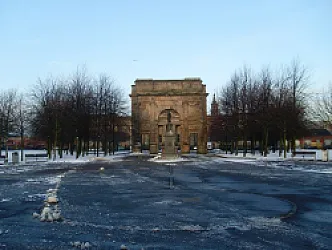

.jpg/320px-St_Enoch_Square_(geograph_4785111).jpg)
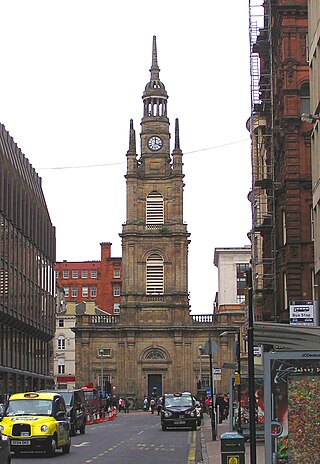




2 Days in Glasgow — A whirlwind love letter to the city's soul
Glasgow stole my heart the moment I stepped onto its wet cobbles. Known affectionately as the "Dear Green Place," the city hums with warmth and wit. Some say it's overrated, but their skepticism fades after one proper wander. I remember my first morning here, coffee steaming, the Argyll Arcade glittering like a secret. This short guide is from a friend who keeps coming back.
Why visit Glasgow? Because it's more than grand facades and famous names. Walk its streets and you'll hear jazz drifting from a tucked-away pub, smell baking from a bakery, and see Victorian stone glow in slanting light. Explore Glasgow City Chambers, marvel at the elegant arches of Argyll Arcade, and pause beneath St George's-Tron Church. This 2 days in Glasgow experience feels lively and intimate. You will taste hearty food, feel the city's generous energy, and leave with pockets full of small discoveries.
Planning can feel overwhelming. There is so much to see you could easily stay for weeks. I get it—time is tight and choices feel brutal. That's why I created this focused Glasgow itinerary. It pares back the noise and points you to nine unforgettable spots. You'll cover historic architecture, theatrical charm at Pavilion Theatre, and stately civic buildings like the County Buildings And Courthouse without racing yourself.
Key tip: Dress in layers and bring a waterproof jacket. Glasgow's weather is famously changeable. You'll walk between indoor marvels and outdoor streetscapes. Staying comfortable means you actually enjoy the city, not rush past it. Also, start your days a bit earlier to beat the crowds at landmark spots. Now let's dive into the itinerary!

Quick Mini Guide to Glasgow
Where to stay:
- Merchant City — close to St George's-Tron Church, independent bars and daytime markets.
- City Centre (Buchanan Street/Argyll Arcade) — walkable to Glasgow City Chambers and shopping.
- Near Pavilion Theatre or Trongate — best for evening shows and a buzzy local dinner scene.
When to visit:
- Late spring–early autumn (May–Sept) for long daylight and outdoor cafes; weekdays for quieter museums.
- Time visits around Glasgow’s festival calendar (music and theatre) if you want a vibrant nightlife buzz.
Things to do:
- Browse Argyll Arcade — classic Victorian jewellery stalls and unique gifts; perfect for window-shopping.
- See St George's-Tron Church for striking Victorian Gothic and photo ops on its steps.
- Catch a performance at Pavilion Theatre — check listings and book ahead for popular shows.
- Tour Glasgow City Chambers and stroll past 40-5o Wilson Street and the County Buildings And Courthouse to admire civic Victorian architecture.
- Book interactive experiences: The Walter Case GLASGOW (mystery walk) and Crazytopia GLASGOW (immersive city game).
Don't forget:
- Waterproof jacket and sturdy shoes for cobbles and sudden showers.
- Reserve theatre/tour slots in advance; many local spots sell out at peak times.
- Ask locals for recommendations — Glaswegians are direct, helpful and proud of hidden gems.
Day 1 - Glasgow
9 POIs to discoverDay 1 - Morning à Glasgow
5 Points of interest - Duration : 3h45 - Distance : 0.6 km - Walking : 0h08
Glasgow City Chambers
- The City Chambers has been the headquarters of Glasgow City Council since 1996.
- It has served as the seat of municipal government in the city since 1889.
- The building is located on the eastern side of George Square.
- The City Chambers is a Category A listed building.
- It was designed by architect William Young in the Beaux arts style.
- The building has been featured in various films and television shows.

40-5o Wilson Street, County Buildings And Courthouse
- The Old Sheriff Court is a former municipal and judicial building in Glasgow, Scotland.
- It is now home to the Scottish Youth Theatre and has been converted into a theatre complex.
- The building is a Category B listed building, featuring neoclassical design and ashlar stone.
- It was originally commissioned to serve as the city and county buildings for Glasgow and Lanarkshire.
- Construction began in 1842 and was completed in 1844, with additional extensions built in the late 19th century.
- The restoration project in 2005 received an award for Best Practice in Regeneration from the British Urban Regeneration Association.
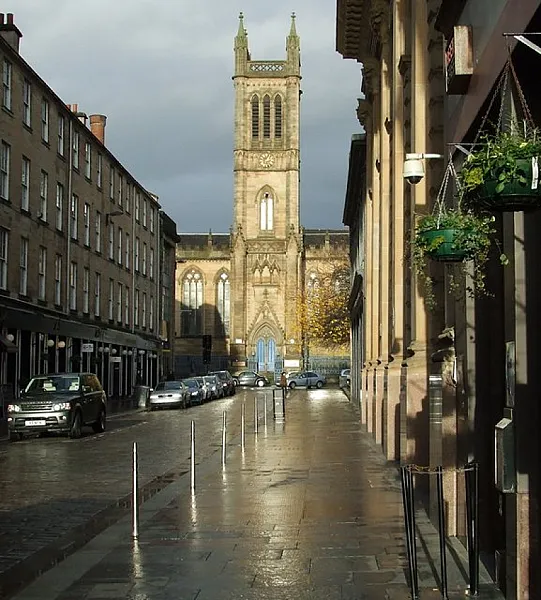
Ramshorn Theatre
- Originally built in 1824 as St David's Parish Church.
- It features stained-glass windows depicting stories from the Bible.
- The church sits within Ramshorn Cemetery, one of Glasgow's oldest burial grounds.
- From 1992 to 2011, the building was used as a theater and performance space.
- Currently, it is home to SCILT, Scotland's National Centre for Languages and the Confucius Institute for Scotland's Schools (CISS), both within the University of Strathclyde.
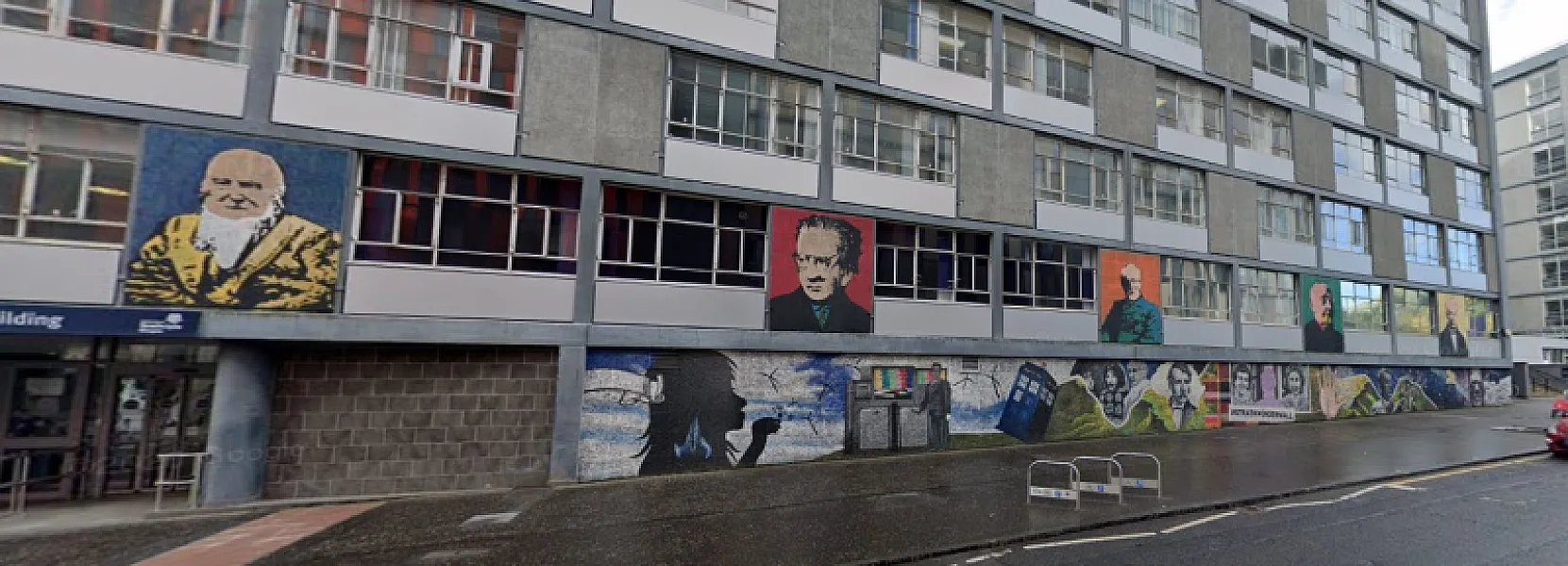
Strathclyde University Mural
- The Wonderwall mural was created in 2014 to commemorate the 50th anniversary of the Royal Charter and the 2014 Commonwealth Games. Honorary Degree for Verity Lambert (1988): Verity Lambert, the Doctor Who producer, received an honorary Doctor of Laws degree from the University in 1988, and her personal archive was later gifted to Strathclyde. Telescope and Nautical Astronomy: The lower half of Wonderwall features a Dansken equatorial telescope, once used for teaching nautical astronomy in the 1920s. Space Engineering Research: The upper half of the mural represents the university's space engineering research group, one of Europe’s largest, focusing on developing innovative space systems and satellite applications. Land-Ship Inspired Mural (1913): Inspired by a 1913 photograph, the mural tells the story of the Land-Ship, a mock navigation bridge used for teaching compass adjustment on the roof of the School of Navigation. Strathclyde People Mural: Celebrates international Strathclyde community members, featuring research pioneers like John Logie Baird, James Young, John Anderson, James Blyth, Henry Faulds, and Andrew Ure. North Portland Street Update: An updated mural includes current students, showcasing the university's diverse and vibrant student and staff community from over 140 countries.
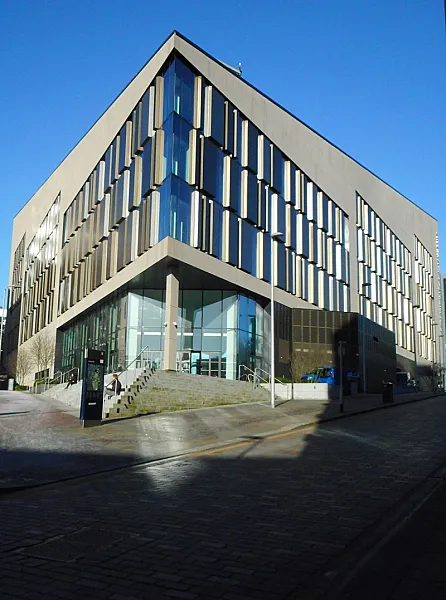
University of Strathclyde Technology and Innovation Centre
- The TIC was funded by the European Regional Development Fund, the Scottish Government, and the University of Strathclyde.
- The nine-story TIC building construction began in March 2012 and was completed in 2014.
- The building is designed to Energy Performance Certificate (EPC) "A" rating standards and spans over 25,000 m2.
- The TIC focuses on research in engineering, science, bio-nanotechnology, business, energy, health, technology, and asset management.
Day 1 - Afternoon à Glasgow
4 Points of interest - Duration : 3h00 - Distance : 1 km - Walking : 0h13
St George's-Tron Church
- St George's Tron Church, a Church of Scotland place of worship, opened in 1808 and is among the oldest buildings in the area.
- Originally named St.
- George's Parish Church, its name was changed to St George's Tron following a congregation merger in 1940.
- Significant ministers included Thomas Chalmers, Tom Allan, and George Baillie Duncan, who contributed to the evangelical movement.
- In 2012, the congregation became independent and relocated, assuming the name of the Tron Church. Rev.
- Philip became the church's minister in 2004 and established Cornhill Scotland, a training organization for Bible preachers and teachers.
- The church features a painting titled "The Last Supper" by artist-in-residence Iain Campbell and is also the "safe zone" for the Glasgow Street Pastors.

Pavilion Theatre
- The Pavilion Theatre, boasts architect Bertie Crewe's design, opened on 29 February 1904 as a Music hall and is one of Glasgow's oldest theatres.
- It has mostly retained its original layout but has seen updates in sound and lighting systems over the years.
- In the early 20th century, many leading music hall artists including Charlie Chaplin have performed here.
- The Pavilion Theatre started producing pantomimes in 1920.
- The theatre managed by Fred Collins and later by his son Horace Collins created many pantomimes, some of which have been recorded on film.
- The theatre is the only privately run theatre in Scotland and one of few independent theatres in Britain outside London.
- It offers a diverse program of populist productions, pantomimes, comedians and touring bands.
- In 2007, it rebranded as the Scottish National Theatre of Variety, featuring numerous stage stars.

Glasgow Royal Concert Hall
- Glasgow Royal Concert Hall is owned by Glasgow City Council and operated by Glasgow Life, an agency of the council.
- The hall was opened in 1990 and was granted Royal status shortly after; it replaced the acclaimed St.
- Andrew's Hall which was destroyed by fire in 1962.
- It serves as the performance base for the Royal Scottish National Orchestra and also hosts a variety of international orchestras, conductors, and soloists.
- The building was designed by Sir Leslie Martin and the Edinburgh-based company RMJM and partners in 1988.
- The Main Auditorium can seat 2,475 people, and the hall includes other performance spaces such as the Strathclyde Suite, the Exhibition Hall, the Buchanan Suite, the Clyde and Lomond foyers, the City of Music Studio, and the VIP Room.
- In addition to classical music, the hall hosts opera, ballet, musical theatre, talks, rock and pop, folk, world and country music, swing, and comedy, and it also exhibits art and photographic exhibitions.

Gallery of Modern Art
- The Gallery of Modern Art (GoMA) is the main gallery of contemporary art in Scotland.
- Opened in 1996, GoMA is in a neoclassical building from 1778 that has undergone many uses and changes.
- Apart from featuring artwork by local and international artists, GoMA also addresses contemporary social issues through major biannual projects.
- Notable exhibits at GoMA include works by David Hockney, Sebastião Salgado, Andy Warhol, John Bellany, and Ken Currie.
- The exteriors of the building include a mirrored pediment known as Tympanum, by artist Niki de Saint Phalle.
- In front of the gallery stands an equestrian statue of the Duke of Wellington, known for often having a traffic cone on its head.
Day 2 - Glasgow
6 POIs to discoverDay 2 - Morning à Glasgow
5 Points of interest - Duration : 3h30 - Distance : 2.1 km - Walking : 0h27
The Briggait
- The Briggait is a category A listed building that was completed in 1873.
- It was originally used as Glasgow's fish market until the late 1970s.
- The building was converted into a shopping center during the 1980s, but the transformation was temporary.
- In the 21st century, the Briggait was converted into artist studios, which opened to the public in August 2010.
- The incorporated steeple, a Category A listed structure dating back to 1659, has been restored.
- The article about this Scottish building or structure is a stub that needs further development.

St Andrew's Cathedral
- The Metropolitan Cathedral Church of Saint Andrew, also known as Glasgow Metropolitan Cathedral, was designed in 1814 in the Neo-Gothic style by James Gillespie Graham.
- It is the mother church of the Roman Catholic Archdiocese of Glasgow and the seat of the Archbishop of Glasgow.
- Its emergence was driven by an increasing demand for a Roman Catholic church due to a significant influx of Irish Catholic immigrants during the Industrial Revolution.
- During the cathedral's construction, the works were often sabotaged, leading to delays and the eventual need for guards to protect the site.
- The cathedral's pipe organ, built in 1903, was relocated there in 1981 from another church that had closed.
- A significant renovation and restoration project started in 2009, which included the installation of new elements, repair of the pipe organ, and gold leaf restoration.
212 Saltmarket, Justiciary Building
- The Justiciary Buildings is a judicial complex specifically used by the High Court of Justiciary, the supreme criminal court in Scotland.
- This building was commissioned to replace the Glasgow Tolbooth as the main municipal and judicial building and it was completed in 1814.
- It is a neoclassical-style building designed by William Stark, composed with ashlar stone and featuring a symmetrical main frontage with seventeen bays.
- The principal rooms in the building are the Justiciary Hall, the burgh courtroom, and the city council chamber, with the lord provost's room and the offices of the town clerks located on the first floor.
- The structure has undergone several extensions and remodels over the years, an important one took place in the early 20th century and similar changes were made to facilities in Edinburgh and Aberdeen.
- Additional extensions in 1997, 2007, and 2016 were made to increase the capacity of the complex, which by 2016, could house nine courtrooms.
.jpg)
St. Enoch Square
- Enoch Square used to be part of Glasgow Green and was the location of a chapel and burial site of St Thenew, mother of St Kentigern.
- The square went through significant architectural changes over centuries involving the construction and demolishment of several buildings, including St.
- Enoch Church and a grass plot grazed with sheep that was removed in 1860.
- In the 1860s, many structures were demolished to make way for a railway, later known as the Glasgow & South Western Railway Company, which crossed the River Clyde.
- Enoch Station opened in 1876, and St.
- Enoch Hotel, which was the largest hotel in Glasgow with over 200 bedrooms, opened in 1879.
- Both were among the first buildings in the city to be lit by electricity.
- In 2014, a refurbishment of the St Enoch Underground, which was created in 1896, started and was completed in 2015.
- It involved several updates, including replacing entrances with new entrance canopies made of glass and steel.
- Today, the St Enoch Centre stands on the site of the former station and hotel, making it the largest glass-covered enclosed commercial area in Europe.
- Additionally, the square hosts the Glasgow Christmas Market every year between November and December.
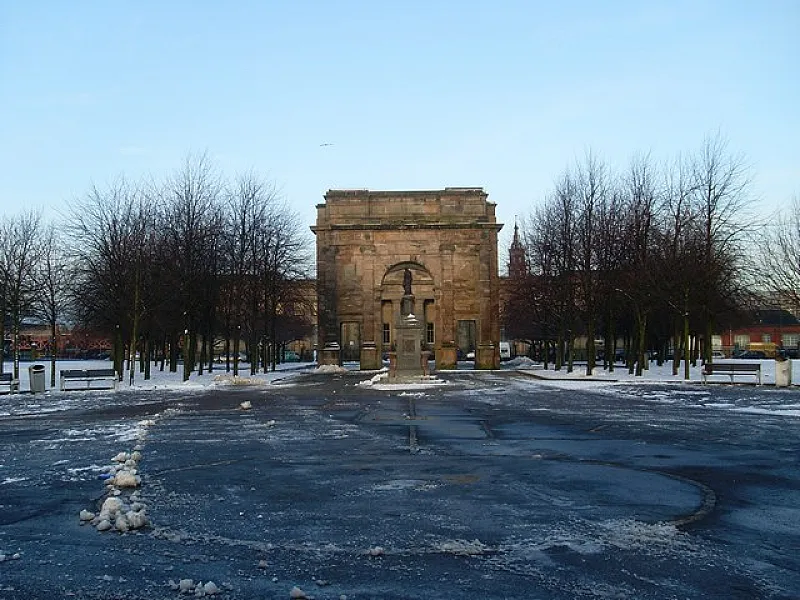
Glasgow Green, Maclennan Arch
- The Assembly Rooms were initially an imposing classical building with a central bay with paired Ionic columns framing a triumphal arch.
- The Rooms were used as a social gathering place for dances, music and other cultural activities.
- In 1847 they became a club, the Atheneum, and were demolished around 1892 to make way for the new General Post Office.
- The central arch was retained, moved to Greendyke Street and, in 1922, to Glasgow Green as a separate triumphal arch.
Day 2 - Afternoon à Glasgow
1 Points of interest - Duration : 0h45 - Distance : 0 km - Walking : 0h00
Argyll Arcade
- The Argyll Arcade is one of the oldest indoor shopping arcades in Europe and Scotland's first indoor shopping mall.
- Built in 1827 in Parisian style, "L" shaped and connecting Argyle Street and Buchanan Street by cutting through old buildings.
- Elegant glass-roofed arcade housing over 30 jewelers and diamond merchants.
- Recognized with Grade A status in 1970 for its architectural and national historic importance, highlighting the innovative use of cast iron construction methods.
- The Argyll Arcade is the only remaining shopping arcade in Scotland and stands as the oldest in Europe.
Where to Stay in Glasgow
Where you sleep in Glasgow matters more than it might in a sprawling city because the best bits are compact and walkable: shopping and Victorian arcades, civic landmarks and theatres are clustered close together. Choosing the right base saves you time and stress on a short 48‑hour visit—wake up within easy reach of the places you want to see and you get more relaxed mornings and a calm night after a busy day.
Glasgow is organised around a busy City Centre spine with a slightly quieter grid of streets to the east and a creative, lively fringe to the west. The city’s heart contains the main shopping streets and civic buildings; just a short walk away lie older lanes and squares where independent shops, galleries and theatres gather. The Subway and mainline rail stations form a compact transport loop, and most central attractions sit within a gentle walking radius.
For a two‑day stay I’d recommend three practical zones. Stay in the core around Buchanan Street and the Argyll Arcade if you want immediate access to shopping, Glasgow City Chambers and easy transit links—the energy here is nonstop and great for first‑time visitors. The nearby Merchant City, around St George’s‑Tron Church and the old County Buildings, gives you cobbled streets, cafés and evening options within steps of historic architecture. If you prefer to be theatre‑minded, pick accommodation on the fringe of the centre close to the Pavilion Theatre area so you can stroll to performances and still be a short taxi or subway ride from the rest of town.
Transport is straightforward: Glasgow Central and Queen Street stations put the national rail network at your feet, the circular Subway is useful for hop‑on hop‑off trips, and buses serve pretty much every corner. For two days you’ll rely mostly on walking between sights; aim to be within a 10–20 minute walk of at least two of your target attractions to keep travel time low and spontaneity high.
When choosing a room, prioritise location over flashy extras: a quiet room on a side street, reliable Wi‑Fi, and clear cancellation terms will reduce stress far more than an extravagant breakfast. If you’re seeing evening shows, ask about noise levels and late check‑in. Book with confidence close to the areas above and you’ll spend your short stay enjoying Glasgow, not commuting through it.
Getting Around Glasgow
Glasgow’s public transport is delightfully straightforward, even if it’s your first time in the city. The compact centre means many sights cluster within easy walking distance, while the wider network of First Bus, ScotRail trains and the little circular Glasgow Subway (the orange "clockwork" line) connects neighbourhoods reliably 🚇. Signage is clear, services are frequent through the day, and drivers and fellow passengers are usually happy to point you in the right direction — so you can feel confident exploring without a car.
One practical tip: look into ticket options before you travel. For single days the Day Ticket or short-term passes often give great value, and if you’re staying longer a ZoneCard or a visitor season pass can save money. Many buses now accept contactless card and mobile payments, which means you can hop on without queuing at a machine — just tap and go. Keep a paper receipt or screenshot if you need proof, and check vehicle notices for any special fares.
Google Maps is your friend in Glasgow: it shows live departures, best walking routes between streets and stations, and gives clear step-by-step transit directions. I always set my destination and then glance at the “departures” times for the nearest stops; if a tram or train is delayed it flags alternatives like a quick bus or a 10-minute walk. For real-time operator info you can also try the First Bus and ScotRail apps, but for sightseeing I find Google Maps keeps things simple and calm 🗺️.
If you want to save money, mix walking with public transport — Glasgow’s city centre is very walkable and you’ll spot hidden shops and street art that you’d miss from a bus. Buy round trips or day passes for multiple hops, travel off-peak where possible, and book longer-distance ScotRail tickets in advance for the best prices. Small choices add up: those short strolls between stops often make the trip more enjoyable and much cheaper than extra fares 🎫.
On my last visit we wandered from Argyll Arcade to St George’s-Tron Church in under 10 minutes, soaking up the music from buskers on Buchanan Street before a quick pit stop for coffee. From the Tron we hopped on a nearby bus using contactless — the driver called out the stop and we were off, arriving at the Pavilion Theatre with time to spare. It felt effortless: a short walk, a friendly driver, and a clear Google Maps route made a theatre-night plan as simple as a postcard itinerary. You’ll find getting around here becomes second nature fast.
What to Pack for Glasgow
Two days in Glasgow means chasing Victorian facades, landmark bridges and surprising modern architecture—mostly on foot between stops and under the famously changeable sky. I’ve done this route twice: once I walked about 12 miles over two days and got caught in a sudden shower; another time I was out 10+ hours following a self-guided architecture trail. Here are the essentials I now never leave home without, and why each one mattered to me.
1. Comfortable walking shoes (Merrell Moab 2 Waterproof recommended): I learned the hard way that pretty city cobbles are not forgiving—after a full day I’d walked 6–8 miles and my bargain shoes gave me blisters. A pair like Merrell Moab 2 (or any sturdy, waterproof sneaker) saved me the second trip: warm, grippy soles for wet pavements and comfortable for long days of standing in front of buildings. Why essential: you’ll be on your feet most of the day and a bad pair ruins the whole visit.
2. Cross-body bag with a zip (small, theft-resistant): Glasgow is friendly but busy spots like Buchanan Street and the Merchant City can get crowded. I carried a small cross-body bag zipped across my chest for a 10+ hour day—kept my phone, Oyster-style card and passport snug and accessible. Why essential: it’s easier to snap it closed, keeps hands free for photos, and reduces pickpocket risk in busy areas.
3. Weather-appropriate layered clothing & waterproof jacket: Glasgow weather changes fast; on one afternoon I was fine in a sweater and 20 minutes later I was drenched. I wear thin merino layers (easy to add/remove) and a packable waterproof shell. Why essential: layers keep you comfortable moving between sunny, windy and drizzly spells without hauling a big coat around.
4. UK power adapter (Type G) and charging cable: I once had to buy a last-minute adapter for £12 at the station—annoying when you could’ve packed one. Most hotels have sockets, but cafés and pubs might not. Why essential: you don’t want to be the person with a dead phone when you need maps, ticket confirmations or to look up a building’s history.
5. Power bank (10,000 mAh recommended): On my longest day my phone was down to 15% by late afternoon after photos, maps and a tram ticket app; a 10,000 mAh power bank got me back to 80% and lasted until bedtime. Why essential: preserves navigation, contact and photo ability without hunting for an outlet mid-tour.
6. Optional extras — compact umbrella & refillable water bottle: I fold a small umbrella into my bag and a 500 ml refillable bottle that I top up at cafés or taps (Glasgow’s water is fine). The umbrella kept me dry during a 20‑minute downpour; the bottle saved me buying 3–4 single-use plastics over two days. Why essential: little comforts that make walking between sites easier and cheaper.
Enjoy Your Trip to Glasgow!
Over two lively days you'll visit nine hand-picked spots across Glasgow, packed with history, striking architecture and local colour. From browsing the Victorian charm of Argyll Arcade to admiring St George's-Tron Church and catching a show at the Pavilion Theatre, this itinerary gives you everything you need to feel the city's energy and see its most memorable corners.
Remember, this is a GUIDE not a strict timetable — be kind to yourself and leave room for the unexpected. The real magic often happens in unplanned moments: getting pleasantly lost in side streets, stumbling on a mural, or lingering in a tiny café. Take a slower pace if something entices you, and allow detours to the riverside or markets. Don’t try to see EVERYTHING; savour a few discoveries and let Glasgow surprise you.
I hope you feel excited — I'm genuinely thrilled for you! Embrace the architecture, the friendly streets and the lively theatres, and make space for serendipity. You're going to love wandering between landmarks, tasting local life and creating unforgettable memories that will stay with you long after you leave.
If you want a playful way to explore, check out our Coddy tours: The Walter Case GLASGOW and Crazytopia GLASGOW. These gamified, interactive routes turn sightseeing into a cheerful challenge — perfect for curious minds and groups who like a little story-driven fun while discovering the city.
Have fun! When you're back, share a favourite moment or ask any questions — I’ll be excited to hear them. Safe travels!
Want more adventure?
Discover our urban escape games to transform your visit into an interactive adventure!















